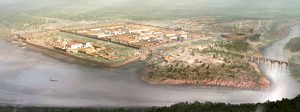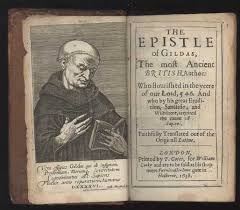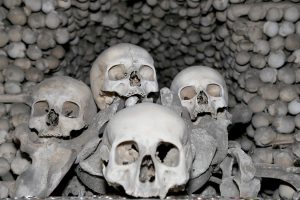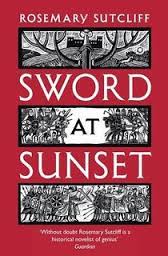I paid my first visit to Sixth Century Dark Ages Britain almost fifty years ago. It was Rosemary Sutcliff’s fault, since it was through the pages of A Sword at Sunset that my juvenile “King Arthur’s Round Table” image of the so-called Dark Ages first began to dissolve – the idea dawning that a more “realistic” portrayal of the period may be possible. Soon afterwards, I became an avid reader of Mary Stewart’s Crystal Cave and the subsequent novels in that series. Brilliant historical fiction!
But I was troubled. Something about the language. Silly things. Like Mary Stewart’s place names – Dinas Emrys, and Maridunum, as examples. Sutcliff’s use of Yr Widdfa and Eburacum. Lots of other novels based in the period that use names such as Gwynedd or Guenhumara. And, because I have a love of languages and etymology, I began to think the unthinkable. Why would authors writing in modern English use pseudo-Welsh or Latin words for places or people and, in doing so, lose the specific descriptive images that the contemporary “Ancient Welsh” Brythonic language(s) would have conjured up?
And I was troubled by many other things too. So I picked up histories like Laing’s Celtic Britain and The Celtic Realms by Dillon and Chadwick, to find out more. Astonishment. It seemed that those beautiful Celtic manuscript illuminations may not, after all, have been the original invention of some highly creative solitary monk on Iona, but borrowed from a much earlier indigenous literacy; that Romano-Britons probably did know one end of a stylus from the other, and had not simply committed to prodigious memory all of their records in some exaggerated “oral tradition”; that the early Dark Ages may be so-named due to Romano-British documentation being lost to us, rather than never having existed; and that “Arthur” may be no more than the imaginative product of some medieval Tolkien.
These things continued to intrigue me, on and off, over the intervening years but I did little about it until circumstance recently caused me to look again at the years we would now call 540-550 AD. Most of Britain had been occupied by the Roman Empire for a period of roughly 400 years. In the aftermath, how much of Roman administrative culture survived, and how much broke down through local warlords carving out their own domains? We don’t know. And how much did people continue to live as they had done under Roman rule? We don’t know that either but, contrary to some of the “old” history, we can now see, archaeologically, that towns like Canterbury, Cirencester, Chester, Gloucester, Winchester, Wroxeter – and presumably many more – continued to be developed, with new-build taking place, well into the Sixth Century and beyond.

Meanwhile, we can be reasonably certain that, from the Third Century onwards, there had been increasing numbers of continental migrants settling mainly in the south and east of the Britannia provinces. We speculate that some of these may simply have been auxiliaries in the Roman army. Or that they were mercenaries, foederati, employed to fight in the various conflicts that beset the period. Or that they were simply economic migrants – Angles, Saxons and Jutes. This is often portrayed as an “invasion”, but there’s little hard evidence for this. Battles are cited. Dates given. Yet all the sources are questionable, to say the least.

The documents normally taken as “primary sources” for this period are: the De Excidio et Conquestu Britanniae of Gildas, originally written, we think, in the early Sixth Century; Saint Bede’s Historia Ecclesiastica (The Ecclesiastical History of the English People), written about two hundred years later; the Historia Brittonum, compiled by some anonymous editor we now know as “Nennius”, also allegedly from the Ninth Century, though the actual manuscripts are much later; the so-called Harleian genealogies, the British Library’s Manuscript 3859, itself dating from the Twelfth Century; the Annales Cambriae (The Annals of Wales) with the earliest copy dating from the Twelfth Century; and such Irish documents as the Annals of Tigernach. And then there are even later literary manuscripts – those that are now frequently described as The Four Ancient Books of Wales, priceless as historical artefacts but entirely unreliable as historical sources for the period.
That sounds like plenty of resource, yet there are very few who would be brave enough to claim these as providing the same level of “evidence” as we might expect for almost any other period of history. Only the De Excidio is contemporary and, after that, we have maybe five or six documents, scattered over the next 600 years and subject to all manner of copying errors, fashion and culture changes, political and religious tampering, literary adaptation, or simple grapevine misinterpretation. For those writing about the early Anglo-Saxon era of the late Sixth Century onwards, all of the manuscripts detailed above may provide something upon which to bite. But for those writing about the hundred preceding years, and about the very uncertain fate of the Romano-British population, they hold little of real value. So, what “new” details of the period did I discover?

Like almost everything else relating to 6th Century Britain, the extent to which Western Europe was afflicted by famines through an “Extreme Weather Event” of circa 535 AD is disputed. I was satisfied, however, that such a natural catastrophe had actually taken place, bringing widespread starvation in its wake.
Similarly, I was satisfied that it was within the boundaries of possibility that Britain was struck by an outbreak of bubonic plague during the period. Procopius and other contemporaries record the plague as devastating Constantinople in 542 AD and then spreading both east and west. Gildas refers to the pestilence in Britain in the same era, though without dating the attack. The documents now known as Annales Cambriae and the Annals of Tigernach record “a great mortality” – believed to be the same plague – hitting Ireland and Wales at this time.
The third uncertainty I faced was the extent to which Rome’s occupation of Britain had left a legacy that still endured more than a hundred years after the Legions had marched away. The archaeological evidence shows that sites like Wroxeter, Chester and Birdoswald were not only still occupied as towns in the mid-Sixth Century but were also subject to the new-build developments I mentioned earlier. But it was the road system that intrigued me. We all know that the Romans built a sophisticated network of highways and byways across Britain, as they did everywhere within the Empire. So I concluded that the roads in question were likely to have still been very much in use. We are blessed that history has left us the Antonine Itinerary, which describes the Empire’s roads in great detail, including their lengths and distances between way-stations, or mansios. The Iter Britanniarum covers Britain’s section of the network, with a different itinerary for each of fifteen major routes. So, Itinerary XII, for example, covers the journey from Carmarthen to Wroxeter.
In truth, we have no real idea what most locations were called at all in Sixth Century Britain. We can speculate, using those names the Romans adopted from what they thought the locals called them, or by looking back retrospectively from accounts and stories written down only hundreds of years later. But there can be no certainty about any of this without some major new archaeological discovery and research and I still pray that Time Team, or the inestimable Mary Beard, may one day devote time to helping us re-discover the period.

Similarly, we know almost nothing about individuals who lived in Britain during the 6th Century. The same accounts and stories written down hundreds of years later leave us a patchwork of “names” that, on closer inspection, turn out to be, far more likely, titles or praise names, simple shadows, which may never have been anything more, in the first place, than folk-tale characters. My favourite, of course, is Gwenhwyfar – the character we all know as Guenivere or Guenhumara. But even a cursory examination will show us that Gwenhwyfar may not originally have been a name at all, but a title, or description. It means White Enchantress, or similar, and explains why there are so many apparently confusing legends with multiple characters all called Gwenhwyfar. Similarly, there are characters like Peredur (Hard-Spear), Vortigern (High Lord), Vortepor (Lord Protector) and scores of others – perhaps not actual names at all, but maybe praise names or self-styled titles.
And, still on language, I remained intrigued by the lack of primary sources for the period from a “Celtic” viewpoint, and the old myth that indigenous Britons must have only kept their lore, traditions and genealogies orally. Yet there are literally hundreds of inscriptions, revealed by archaeology, dating from around 500 BC onwards, in their own Celtic languages, though using Etruscan, Greek or Latin alphabets. These include entire poems, such as that found in 1887 at Deux-Sèvres – a hymn to the goddess Epona. So, literate Celtic Britons, who then lived alongside the literacy of the Mediterranean world for 400 years, and it seemed entirely inconsistent to me that Romano-Britons should have written no texts on their own history, philosophy and beliefs. And is it pure coincidence that the only fragments of Celtic language texts from the 6th Century are Christian documents, such as the famous An Cathach, attributed to St Columba? Peter Berresford Ellis, in his excellent study, A Brief History of the Celts, provides an entire chapter on Celtic literacy, and cites the references which imply that Saint Patrick, “in his missionary zeal”, burned hundreds of non-Christian texts. If true, then how widespread was the practice of Christians burning “pagan” texts?
All of which brings me back to the only contemporary primary written source for those studying Fifth and early-Sixth Century Britain. This is the text by Gildas called De Excidio et Conquestu Britanniae. Gildas, a Welsh-Breton priest, apparently wrote one hundred and ten historical chapters and admonitions, upon which Bede drew heavily almost two hundred years later – although the oldest actual manuscript of the De Excidio dates from the Eleventh Century. For students of the Dark Ages it’s still invaluable although, over the last hundred years, a growing body of academics and researchers have questioned the authenticity of the work and, at times, whether Gildas was even the author’s real name.
My conclusion, of course, is that the period between 500 AD and 600 AD is effectively a “lost century” in British history. But at least we know with more certainty what happened next. The Anglo-Saxon Chronicles and other sources confirm the way in which Angles, Saxons and Jutes consolidated territory into the Kingdoms of Northumbria (most of what we now know as northern England), Mercia, Anglia, Wessex, Essex, Sussex and Kent, with the more specifically “Celtic” folk confined to the Southwest, Wales, Cumbria and the lands north of Hadrian’s Wall. According to the Chronicles, there were one or two more battles in the period, like that at Deorham around 577 AD. But all of the foregoing contrived to give me a series of intriguing premises. What if, indeed, there was no “Arthur” – simply post-Roman warlord rivalries, filling the political vacuum and collectively inspiring the much later legends? What if the Black Hags appearing so often in Celtic mythology were actually the outward symptoms of plague? What if post-Roman Britons were also devastated by the effects of the Extreme Weather Event? What if the “invasions” by Angles, Saxons and Jutes were no more than economic migrations by which those folk, for the most part, were simply the Sixth Century’s answer to labour and skills shortage? What if most of what we’ve been taught about the period comes down to us simply from propaganda aimed essentially at further boosting the development of Christianity in Britain? What if (the corollary), for the same reason, the true record of Romano-British culture and philosophy had to be deliberately expunged?
And what if these things, together, conspired to “steal” Britain’s Sixth Century from us? All these are the possibilities which inspired my novel, The Song-Sayer’s Lament.
(This article first appeared on the English Historical Fiction Authors website)

Excellent article David. A very good overview of the ‘problems’ of the period.
Thanks Mak. Comments much appreciated.
A very good article, with some conclusions and assumptions which I fully support.
A few remarks though. The EWE might have been real enough (it seems tree-ring studies confirm it) but the effects remain unclear. In the past, palgues and other ‘events’ were used to explain why the British lost Britain to the English, but of course that could never explain why the English seen to be less affected. If the English came in as labour, then why do we see a British migration to the continent? Why not a ‘celtic migration’ from war-torn Gaul to Britain?
Indeed we need not see the Adventus Saxonum as a string of never-ending battles, nor as an ‘ethnic cleansing’. Even less English sources survive of this period, but it seems logical that strife was as much involved as accomodation. The Romans came and stayed for 400 years (no, the legions never ‘marched home’) and yet the British seem to have held on to some sort of Britishness – language, customs, at least for the commoners outside the Roman towns. Yet this is lost when the English arrive, or at least after a period of time. All due to the EWE? Or to a more thorough accomodation towards a new English elite? I doubt that very much.
Thanks for these comments. Much appreciated. I guess what I was trying to do was to put some space between this particular work of fiction (I always make it clear that these are only works of fiction) and, I think, every other single novel of this period – in which the entire emphasis is always purely and simply on Celt v. Saxon strife. The article is just my feeble attempt to “pose some questions.” Glad you liked it overall though.
why not an “end of empire”similar to the die hard white regime of Rhodesia?
romanization perhaps only a thin veneer,Celtic natives following a traditional lifestyle,Roman army as a prime mover in introducing non native elements,Iraqi boatmen on Hadrian wall?German recruitment a known element in late Roman army,a natural disaster,plus endemic series if campaigns by general’s ,all seizing purple?
Will we ever know?
Hi John. Thanks for your comments and good to see you at the Write Blend talk. Lots of examples from “end of Empire” histories. Personally, I like the comparisons between post-Roman and post-Ottoman periods. But Romanisation a thin veneer? I doubt that. The almost unique strength of the Roman Empire was that its “conquered” people themselves became full-blown Romans. The closest comparison, I reckon, must be what happened in the former provinces of Gaul – another strongly Celtic world, absorbed into the Empire, and retaining many, many of the Empire’s trappings and organisational structures even though the Franks took over pretty much where the Romans left off. Yet there, in those neighbouring lands, we have quite a quite detailed knowledge and written details of what was happening under the Merovingian warlords and kings in that very same period, 500-600 AD. So we’re still stuck with the same conundrum – what was it that was different post-Roman Britain. As you say, we’ll probably never know – though I’m going to do my damnedest to try and get somebody serious (Mary Beard, maybe) to look at this again. Good luck with your own work. Dave